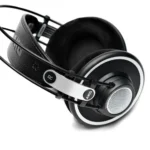Open-back headphones, often referred to simply as “open headphones,” stand out immediately due to their unique design. Unlike closed-back headphones, which seal the ear and isolate sound, open headphones feature speaker enclosures that are intentionally left open. This design allows air and sound to flow freely through the ear cups, resulting in a listening experience that differs from traditional headphones in several notable ways.
The openness of the design significantly impacts how sound is delivered and perceived. Instead of confining the audio within the ear cups, open headphones create a natural, spacious soundstage. The result is audio that feels less boxed in, often described as “room-like.” This effect is especially appreciated by audiophiles for its ability to mimic the experience of listening to speakers rather than headphones. However, this same feature can feel peculiar to those accustomed to the immersive isolation of closed-back designs.
One of the main reasons open headphones are considered unusual is their lack of sound isolation. Because sound escapes freely, those nearby can hear what’s being played, and external noises can easily bleed in. This might feel counterintuitive for anyone who associates headphones with private listening. Open designs also require more thoughtful usage environments, as they are better suited for quiet, controlled settings rather than public spaces.
This openness shifts the entire purpose of the headphone experience. Instead of blocking out distractions or focusing on bass-heavy sound, open-back headphones aim to replicate audio as realistically as possible. While this design might sound “weird” to newcomers, many enthusiasts regard it as a feature rather than a flaw. The unconventionality of open headphones lies in their ability to prioritize audio authenticity over isolation, sparking curiosity and debate in the world of modern audio gear.
How Open Headphones Differ from Traditional Designs
Open headphones, often categorized by their distinct design and sound characteristics, stand apart from traditional closed-back headphones in several significant ways. At the heart of the difference lies their open-back design, where the ear cups allow air and sound to pass freely through the back of the drivers. This structural choice fundamentally impacts both the listening experience and the physical construction of the headphones.
One of the most notable differences is how open headphones produce sound. Unlike traditional closed-back designs that isolate the listener by sealing off the ears, open-back headphones are designed to create a more natural, expansive soundstage. This design mimics the experience of listening to speakers in a room rather than sound being confined to the ear. As a result, the listener perceives audio as wider and more immersive, with individual instruments and vocals appearing more spatially distinct.
Another key difference is how each design handles external noise. Open headphones intentionally sacrifice sound isolation, allowing ambient noise to intermingle with the audio. While this enhances the sense of realism for some, it makes these headphones unsuitable for noisy environments or public use. In contrast, traditional closed-back designs provide a sealed environment, effectively blocking outside noise and preventing audio leakage.
Comfort also sets open headphones apart. Their design often favors lighter weight and breathable ear cups, reducing ear fatigue during extended listening sessions. However, this open structure makes them less portable, as they are less durable and susceptible to exposure from external elements.
In terms of use cases, traditional closed-back headphones appeal to DJs, studio professionals, and commuters due to their privacy and isolation. Open-back ones cater more to audiophiles and home users seeking precision and depth in music playback. These fundamental differences highlight how the choice between the two goes beyond aesthetics, aligning with individual listening preferences and needs.
First Impressions: Unboxing the Unique Headphones
Unboxing the unique “open” headphones immediately displays an unusual design that sets them apart from traditional models. The packaging itself hints at their unconventional nature, offering minimalist aesthetics with subtle branding. A snug-fitting cardboard box slides open to reveal the headphones housed securely in foam padding, providing a reassuring touch of care in presentation.
Inside the box, the contents are neatly organized. Alongside the headphones, there’s a small accessory pouch containing a charging cable, a quick-start guide, and an additional set of ear loops. The quick-start guide uses clear visuals, making setup approachable, even for those unfamiliar with unconventional audio gear. No unnecessary frills accompany the packaging, but a thoughtful inclusion of eco-friendly materials ensures that sustainability-conscious buyers won’t feel overlooked.
The headphones stand out immediately due to their unique skeletal framework. Instead of enclosing the ears, they feature an open-loop design that hovers near the ears without making direct contact. The lightweight construction, made possible by the use of high-grade plastics and metal accents, feels sturdy yet airy when held. A closer examination reveals controls streamlined onto the arms, with buttons for volume, playback, and pairing neatly concealed.
The included charging cable uses a proprietary magnetic connector, which promises secure and convenient recharging. Some may miss the presence of a carrying case, but the compact design ensures portability does not require extras. The accessory pouch, while sufficient for cables, leaves limited space for protective storage.
Overall, the initial unboxing experience intrigues with its clean, functional layout and distinctive product design. Each element reinforces its focus on innovation, promising something out of the ordinary for audio enthusiasts.
Sound Quality Breakdown: How Do They Perform?
The sound quality of the unusual “open” headphones offers a unique listening experience. Unlike traditional closed-back headphones, these use an open design to project audio in a way that interacts with the surrounding environment. The result is a more natural and spacious soundstage, but it raises important questions about performance across different frequency ranges, overall clarity, and suitability for varied audio genres.
Low Frequencies (Bass)
The bass response is present but not as pronounced as in closed-back headphones or in-ear monitors. Due to the open design, the physical sensation of deep bass impact is somewhat muted, which is evident in bass-heavy music genres such as hip-hop or EDM. However, it compensates for this by providing a warmer bass tone that feels less artificial and more organic.
Mids
The midrange frequencies deliver a clean and balanced sound, making vocals and instruments come through with clarity. The lack of enclosure ensures that midrange tones do not feel congested, which benefits acoustic music and genres that emphasize vocals. However, in louder environments, the subtlety of the midrange may occasionally get overshadowed by ambient noise.
High Frequencies (Treble)
The treble is crisp and detailed, though slightly laid-back compared to other high-resolution headphones. This tuning prevents sharp or harsh high tones, particularly noticeable in orchestral tracks, but sacrifices some brightness that audiophiles may seek. The open design promotes airy treble delivery, enhancing spatial details in instrumental recordings.
Imaging and Soundstage
One of the standout aspects lies in its ability to create a broad soundstage. The user gets the sensation of sound moving around them rather than being confined to their ears. Imaging feels precise, enabling listeners to pinpoint specific instruments or audio cues.
Noise Leakage and Isolation
The open-back concept naturally leads to significant noise leakage and poor noise isolation. These headphones are less suited for quiet environments where disturbing others could be a concern or noisy settings where external sounds may disrupt listening.
Overall, their performance leans toward casual listening experiences and specific music genres, offering a new perspective for those who prioritize openness and natural resonance over fully immersive isolation.
Comfort and Fit: Analyzing the Open Design
The open design of these headphones introduces a unique approach to comfort and fit that deviates from traditional over-ear or in-ear models. Unlike conventional designs, open headphones typically rest lightly against the ear without creating a seal, which alleviates pressure build-up during extended use. This design allows for better airflow, reducing ear fatigue commonly associated with closed-cup or in-ear buds. For users who dislike the sensation of invasive ear tips or the weight of heavy ear cups, this design offers an alternative that prioritizes minimal intrusion.
One of the most notable factors is the absence of tight clamping force. Many open headphones rely on a looser grip to achieve an unrestrictive feel. This makes them ideal for listeners who find traditional headphones uncomfortable during long sessions. However, this looser fit may be less ideal when engaging in physical activities, as the headphones can shift or even fall off with sudden movements.
The overall structure of the open design is often lightweight, which further contributes to its comfort. Some models feature silicone or foam padding around the drivers for additional cushioning, ensuring they rest softly without applying undue pressure to the skin. The materials used also play a role; breathable fabrics or smooth, molded plastics are common to prevent irritation.
Despite the benefits, the open design can present challenges for users with smaller or larger-than-average heads. Without adjustability in the frame or straps, achieving an optimal fit may become difficult. Additionally, the lack of passive noise isolation necessitates testing the fit more critically, as even small shifts in position can affect listening consistency or allow distractions from external sounds.
Use Case Scenarios: Where These Headphones Excel
These “open” headphones bring a distinct set of advantages that cater to specific situations. Unlike traditional closed-back designs, their open-ear structure fosters an environment where users can remain aware of their surroundings while enjoying audio playback. This characteristic makes them particularly valuable in diverse and dynamic contexts.
1. Office and Work-from-Home Environments
Open headphones excel in professional settings where situational awareness and communication are essential. They allow users to participate in virtual meetings or calls without completely drowning out background sounds, such as a colleague approaching or a ringing doorbell. Their lightweight design also ensures comfort during prolonged use, a key factor for professionals working extended hours.
2. Outdoor Activities
For joggers, cyclists, or walkers, these headphones provide an ideal solution by maintaining situational awareness. Users can hear approaching vehicles or other environmental cues while enjoying music or podcasts. The open-ear configuration prioritizes safety, making these wearable devices highly suited for outdoor workouts or urban commutes.
3. Gaming and Competitive Play
Gamers benefit from these headphones because they can create a layered soundstage that mimics open-space acoustics. The design enhances spatial awareness in first-person shooter or role-playing games, giving players the edge they need to anticipate movements and ambient activity. At the same time, the lack of complete sound isolation can allow communication with roommates or family members without needing to remove the headphones.
4. Casual Listening at Home
For those who enjoy light background music while cooking, cleaning, or performing household tasks, these headphones let ambient sounds, such as timers or calls for attention, coexist with their auditory experience. Furthermore, they are convenient when multitasking, as users can alternate focus without missing external cues.
This adaptability ensures that these headphones cater to specific users with unique demands, offering both an immersive and practical audio experience.
The Pros and Cons of Open Headphones
Open headphones possess unique characteristics that distinguish them from their closed-back counterparts. Understanding their advantages and potential drawbacks is critical for anyone considering this type of audio equipment.
Pros of Open Headphones
- Natural Soundstage: Open-back headphones are praised for their expansive and airy sound. Due to the unsealed design, sound is not contained within the ear cups, creating a listening experience that feels more like being in a room with live music. This natural sound profile is particularly valued by audiophiles and sound engineers.
- Better Ventilation: The open construction allows air to flow freely through the ear cups, preventing ears from overheating during long listening sessions—ideal for users who prioritize comfort.
- Reduced Ear Fatigue: The open design typically results in less pressure on the ears, leading to a more relaxed and enjoyable listening session over time.
Cons of Open Headphones
- Lack of Noise Isolation: One of the biggest trade-offs is the absence of sound isolation. Ambient noise can easily enter, and music can leak out, making them unsuitable for noisy environments or shared spaces.
- Limited Bass Response: Open headphones often lack the deep and punchy bass that closed-back designs can achieve. For bass-heavy music genres, this may be less satisfying.
- Durability Concerns: The open housing exposes internal components to potential damage from dust or moisture, necessitating extra care in maintenance and use.
- Not Ideal for Portability: Their design is generally bulkier and less suitable for on-the-go use compared to smaller, closed-back alternatives that provide sealed sound.
Open headphones shine in quiet settings where sound fidelity is prioritized, but they present challenges in environments requiring discretion or isolation. Evaluating these pros and cons helps users determine if they align with their specific needs.
How the ‘Weird’ Design Impacts Everyday Use
The unconventional design of these “open” headphones introduces unique experiences during everyday activities, redefining how users approach audio devices. Unlike traditional headphones, which use over-ear or in-ear mechanisms to isolate sound, the open design allows environmental sound to pass through freely. This feature significantly enhances situational awareness, especially for individuals commuting in busy urban areas, walking in high-traffic zones, or using headphones during exercise outdoors.
The structural design is lightweight and lacks typical pressure points associated with over-the-head or in-ear options. This ensures prolonged comfort, which is particularly beneficial for individuals who require headphones for extended work periods, such as those seated in home offices or attending virtual meetings. However, the absence of full-ear coverage inherently limits noise isolation. Users in loud environments may find it challenging to fully immerse themselves in the audio without raising the volume, which could potentially lead to discomfort or ear strain.
From a functionality perspective, the non-intrusive fit is also highly advantageous for users wearing glasses, helmets, or other headgear. The absence of ear cups or intrusive buds reduces interference, making the headphones more compatible with such accessories. On the other hand, the open design means that audio may leak, allowing nearby individuals to hear snippets of what the user is listening to. This could deter some from using them in quiet public spaces like libraries or during flights.
Daily durability benefits from the minimalistic build, as fewer moving parts reduce potential wear and tear. The weird design undeniably shifts standard expectations for personal audio use, blending accessibility with novel compromises.
Comparing Them to Competitors: Are They Worth It?
When evaluating “open” headphones, such as the ones tested, it’s essential to view them against competitors in the same category. Unlike traditional over-ear or in-ear models, open headphones rely on a unique design that keeps the ears uncovered, prioritizing environmental awareness and comfort. This puts them in direct competition with bone conduction headphones and other open-back earpieces.
Audio quality is often a deciding factor. Compared to competitors like bone conduction models, open headphones generally deliver better sound fidelity since they don’t depend on vibrating the skull to create sound. This results in a more natural and fuller listening experience. However, they still fall behind in producing the deep bass and noise isolation offered by premium closed-back alternatives.
In terms of build and comfort, the open headphones are lighter and less intrusive. Competitors such as open-back over-ear models, though highly rated for soundstage, tend to be bulkier and less portable. Similarly, bone conduction headphones may offer an equally lightweight option, but they can cause subtle discomfort over time due to their reliance on pressured vibrations near the temples.
Price is another critical factor. Most open headphones sit at a similar price range to bone conduction competitors. However, they’re often more affordable than high-end, open-back over-ear models. This makes them a solid mid-tier option for people seeking a balance of functionality and value, though they might lack advanced features like active noise cancellation or premium materials seen in pricier alternatives.
When considering use cases, open headphones and bone conduction models share a niche appeal. They’re ideal for outdoor activities, commuting, or any scenario where environmental awareness is imperative. Yet, competitors offering sealed designs far outperform them in controlled, immersive environments like home studios or gaming setups.
By comparing market alternatives, key differences emerge, revealing distinct trade-offs for various options.
The Verdict: Would I Recommend These Headphones?
When evaluating whether these unusual “open” headphones deserve a spot on someone’s audio gear list, several factors come into play. Assessing their design, functionality, sound quality, and comfort reveals a balanced picture of their overall appeal and limitations.
First, the distinct open-ear design can be a game-changer for users who prioritize situational awareness. Unlike traditional over-ear or in-ear models, these headphones leave the ear canal uncovered, allowing environmental sounds to filter in. This is particularly beneficial for outdoor use, such as jogging or biking, where maintaining awareness of surroundings is essential. However, for anyone seeking immersive or isolated listening, the lack of noise-canceling properties may be a significant drawback.
From an audio performance perspective, the sound profile may divide opinions. While clarity and mids are commendable, bass response could feel underwhelming for genres like hip-hop or EDM. Those who prioritize balanced audio rather than thumping low frequencies may find them sufficient. Notably, volume limitations could pose an issue in louder environments, as the open design naturally limits how much sound can be contained.
Comfort and usability are areas where these headphones stand out. By resting on the ear or cheek rather than inserting into the ear, they reduce potential discomfort during extended use. Users with sensitivity to traditional earbuds may value this feature. Additionally, their lightweight build ensures they are barely noticeable during wear. However, they may not stay securely in place during vigorous activities, depending on the fit.
It’s worth noting some practical concerns. The headphone’s performance in windy conditions can be problematic, leading to sound distortion. Furthermore, their open nature inherently leads to sound leakage, which may disturb others in quieter settings.
This unique design caters to a specific niche. While they may not suit everyone’s needs, they offer distinct advantages for particular use cases.
Final Thoughts on Embracing Unique Audio Innovations
Exploring unconventional audio devices, like “open” headphones, underscores the rapid evolution of sound technology and its potential to reshape the way audio is experienced. These designs break free from traditional paradigms, offering users novel features catering to specific needs, whether it’s heightened situational awareness, improved comfort, or unique aesthetic appeal.
“Open” headphones often prioritize external awareness. Unlike closed designs, they allow environmental sounds to mix with playback audio, enhancing safety during outdoor running or cycling. This characteristic can also encourage natural interactions in shared spaces, ensuring users remain socially engaged while enjoying personal audio content. Their lightweight, airy build frequently promotes long-term wearability, proving valuable for extended use. These features cater especially well to modern lifestyles where multitasking is key.
However, such innovations may come with trade-offs. Audio enthusiasts accustomed to the immersion of noise-isolating headphones might find the sound profile less detailed. Additionally, due to their open design, these devices might not suit all scenarios, especially in noisy environments when focus is essential. To address diverse user preferences, manufacturers continuously tweak these models to blend performance with situational practicality.
Overall, the advent of imaginative designs like “open” headphones reveals a trend toward tailoring technology for specific lifestyles and needs. By challenging conventional norms, these innovations redefine user expectations and exemplify how form and functionality can combine to elevate daily experiences. Each iteration comes closer to balancing design creativity with the demands of an increasingly connected, audio-centric world. This delicate interplay between form and practicality remains at the heart of unique audio innovation.










